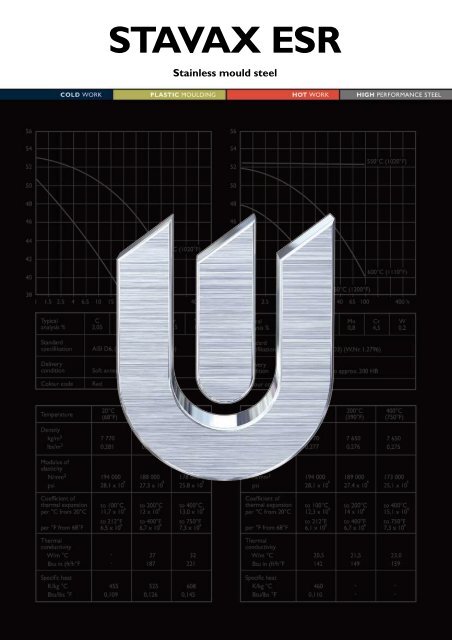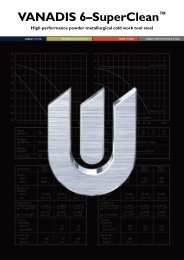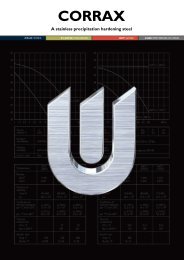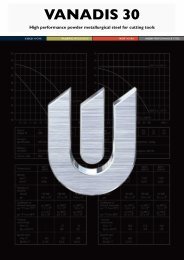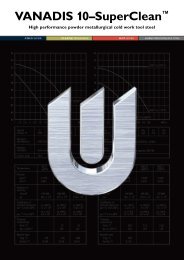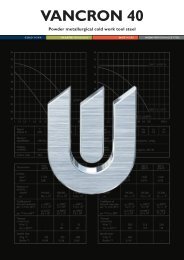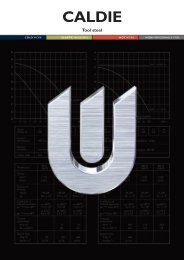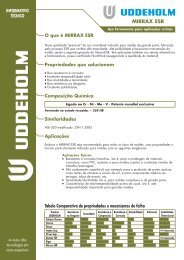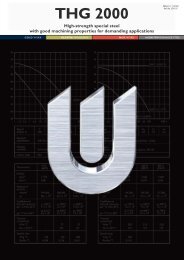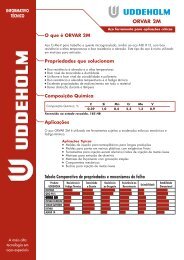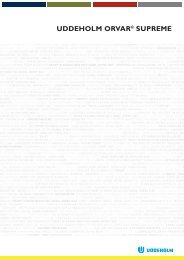STAVAX ESR - Uddeholm
STAVAX ESR - Uddeholm
STAVAX ESR - Uddeholm
Create successful ePaper yourself
Turn your PDF publications into a flip-book with our unique Google optimized e-Paper software.
<strong>STAVAX</strong> <strong>ESR</strong>Stainless mould steel
<strong>STAVAX</strong> <strong>ESR</strong>This information is based on our present state of knowledge and isintended to provide general notes on our products and their uses. It shouldnot therefore be construed as a warranty of specific properties of theproducts described or a warranty for fitness for a particular purpose.2
<strong>STAVAX</strong> <strong>ESR</strong>General<strong>STAVAX</strong> <strong>ESR</strong> is a premium grade stainless tool steelwith the following properties:• good corrosion resistance• good polishability• good wear resistance• good machinability• good stability in hardening.The combination of these properties gives a steelwith outstanding production performance. Thepractical benefits of good corrosion resistancein a plastics mould can be summarized as follows:• Lower mould maintenance costs.The surface of cavity impressions retain theiroriginal finish over extended running periods.Moulds stored or operated in humid conditionsrequire no special protection.• Lower production costs.Since water cooling channels are unaffected bycorrosion (unlike conventional mould steels),heat transfer characteristics, and thereforecooling efficiency, are constant throughout themould life, ensuring consistent cycle times.These benefits, coupled with the high wear resistanceof <strong>STAVAX</strong> <strong>ESR</strong>, offer the moulder lowmaintenance,long-life moulds for the greatestoverall moulding economy.Note! <strong>STAVAX</strong> <strong>ESR</strong> is produced using the Electro-Slag-Refining (<strong>ESR</strong>) technique, resulting in a verylow inclusion content.ApplicationsWhilst <strong>STAVAX</strong> <strong>ESR</strong> is recommended for all types ofmoulding tools, its special properties make itparticularly suitable for moulds with the followingdemands:• Corrosion/staining resistance, i.e. for mouldingof corrosive materials, e.g. PVC, acetates, andfor moulds subjected to humid working/storageconditions.• Wear resistance, i.e. for moulding abrasive/filled materials, including injection-mouldedthermosetting grades. <strong>STAVAX</strong> <strong>ESR</strong> is recommendedfor moulds with long production runs,e.g. disposable cutlery and containers.• High surface finish, i.e. for the production ofoptical parts, such as camera and sunglasseslenses, and for medical containers, e.g. syringes,analysis phials.RecommendedType of mouldhardness HRCInjection mould for:thermoplastic materials 45–54thermosetting materials 45–54Compression/transfer moulds 50–54Blow moulds for PVC, PET, etc. 45–54Extrusion, pultrusion dies 45–54Typical C Si Mn Cr Vanalysis % 0,38 0,9 0,5 13,6 0,3StandardspecificationDeliveryconditionColourcodeAISI 420 modifiedSoft annealed to approx. 200 HB.Orange/black<strong>STAVAX</strong> <strong>ESR</strong> core to makedisposable polystyrene beakers.Millions of close tolerance mouldingswith a very high surface finishhave been produced.3
<strong>STAVAX</strong> <strong>ESR</strong>PropertiesPHYSICAL DATAHardened and tempered to 50 HRC. Data at roomand elevated temperatures.Temperature 20°C 200°C 400°C(68°F) (390°F) (750°F)Density, kg/m 3 7 800 7 750 7 700lbs/in 3 0,282 0,280 0,277Modulus of elasticityN/mm 2 200 000 190 000 180 000tsi 12 900 12 300 11 600psi 29,0 x 10 6 27,6 x 10 6 26,1 x 10 6Coefficient of thermalexpansion/°C from 20°C – 11,0 x 10 -6 11,4 x 10 -6/°F from 68°F – 6,0 x 10 -6 6,5 x 10 -6Thermalconductivity*W/m °C 16 20 24Btu in/(ft 2 h °F) 110 138 166Specific heatJ/kg °C 460 – –Btu/lb, °F 0,110 – –* Thermal conductivity is very difficult to measure. The scattercan be as high as ±15%.TENSILE STRENGTH AT ROOM TEMPERATUREThe tensile strength values are to be considered asapproximate only. All samples were taken from abar (in the rolling direction) 25 mm (1") diameter.Hardened in oil from 1025 ±10°C (1880 ± 20°F) andtempered twice to the hardness indicated.Hardness 50 HRC 45 HRCTensile strength RmN/mm 2 1 780 1 420kp/mm 2 180 145tsi 114 92psi 256 000 206 000Yield point Rp0,2N/mm 2 1 460 1 280kp/mm 2 150 130tsi 95 83psi 213 000 185 000The influence of tempering temperature on corrosionresistance.Increasing corrosion resistanceCorrosionresistance100 200 300 400 500 600Tempering temperature°CHeat TreatmentSOFT ANNEALINGProtect the steel and heat through to 890°C(1630°F). Then cool in the furnace at 20°C (40°F)per hour to 850°C (1560°F), then at 10°C (20°F) perhour to 700°C (1290°F), then freely in air.STRESS-RELIEVINGAfter rough machining the tool should be heatedthrough to 650°C (1200°F), holding time 2 hours.Cool slowly to 500°C (930°F), then freely in air.HARDENINGPreheating temperature: 600–850°C (1110–1560°F)Austenitizing temperature: 1020–1050°C (1870–1920°F), but usually 1020°C–1030°C (1870–1885°F).Temperature Soaking time* Hardness before°C °F minutes tempering1020 1870 30 56± 2 HRC1050 1920 30 57± 2 HRC* Soaking time = time at hardening temperature after the tool isfully heated through.Protect the part against decarburization andoxidation during hardening.CORROSION RESISTANCE<strong>STAVAX</strong> <strong>ESR</strong> is resistant to corrosive attack bywater, water vapour, weak organic acids, dilutesolutions of nitrates, carbonates and other salts.A tool made from <strong>STAVAX</strong> <strong>ESR</strong> will have goodresistance to rusting and staining due to humidworking and storage conditions and when mouldingcorrosive plastics under normal production conditions.<strong>STAVAX</strong> <strong>ESR</strong> shows the best corrosion resistancewhen tempered at low temperature and polished toa mirror finish.4
<strong>STAVAX</strong> <strong>ESR</strong>QUENCHING MEDIA•Oil• Fluidized bed or salt bath at 250–550°C(480–1020°F), then cool in air blast• Vacuum with sufficient positive pressure• High speed gas/circulating atmosphere.In order to obtain optimum properties, the coolingrate should be as fast as is concomitant withacceptable distortion. When heat treating in avaccuum furnace, a 4–5 bar overpressure is recommended.Temper immediately when the tool reaches50–70°C (120–160°F).Hardness, grain size and retained austenite as afunction of the austenitizing temperature.GrainsizeASTM Hardness HRC10 609 58Holding time60 min.876543215654Retained austenite %4052504846RetainedHolding time austenite44 20 min.4240960 980 1000 1020 1040 1060 1080 °C1760 1795 1830 1870 1905 1940 1975 °FAustenitizing temperatureTEMPERINGChoose the tempering temperature according to thehardness required by reference to the temperinggraph. Temper twice with intermediate cooling toroom temperature. Lowest tempering temperature180°C (360°F) for small simple inserts, but 250°C(480°F) is the preferred minimum. Holding time attemperature minimum 2 hours.Tempering graphHardnessHRC6055504540353025Grain size1020°CRetained austenite1030°C302010Retained austenite %141050°C12100 200 300 400 500 600 700°C200 400 600 800 1000 1200°FTempering temperature108642Note: 1. Tempering at 250°C (480°F) is recommendedfor the best combination of toughness, hardnessand corrosion resistance.Note: 2. Above curves are valid for small samples.Achieved hardness depends on mould size.Note: 3. A combination of high austenitizingtemperature and low tempering temperature
<strong>STAVAX</strong> <strong>ESR</strong>MachiningrecommendationsThe cutting data below are to be considered asguiding values which must be adapted to existinglocal conditions. More information can be found inthe <strong>Uddeholm</strong> publication “Cutting Data Recommendation”.TURNINGTurning with carbide Turning withRough Fine high speedCutting data Rough Fine steelparameter turning turning Fine turningCutting speed (v c )m/min 160–210 210–260 18–23f.p.m. 525–690 690–850 60–75Feed (f)mm/r 0,2–0,4 0,05–0,2 0,05–0,3i.p.r. 0,008–0,016 0,002–0,008 0,002–0,01Depth of cut (a p )mm 2–4 0,5–2 0,5–3inch 0,08–0,16 0,02–0,08 0,02–0,1Carbidedesignation ISO P20–P30 P10 –Coated Coatedcarbide carbide orcermetMILLINGFace and square shoulder face millingMilling with carbideCutting data parameter Rough milling Fine millingCutting speed (v c )m/min 180–260 260–330f.p.m. 600–865 865–1080Feed (f z )mm/tooth 0,2–0,4 0,1–0,2in/tooth 0,008–0,016 0,004–0,008Depth of cut (a p )mm 2–4 0,5–2inch 0,08–0,16 0,02–0,08Carbide designation ISO P20–P40 P10–P20Coated carbide Coated carbideor cermetDRILLINGHigh speed steel twist drillsDrill diameter Cutting speed (v c ) Feed (f)mm inch m/min f.p.m. mm/r i.p.r.–5 –3/16 12–14* 40–47* 0,05–0,10 0,002–0,0045–10 3/16–3/8 12–14* 40–47* 0,10–0,20 0,004–0,00810–15 3/8–5/8 12–14* 40–47* 0,20–0,30 0,008–0,01215–20 5/8–3/4 12–14* 40–47* 0,30–0,35 0,012–0,014* For coated HSS drill v c =20–22 m/min. (65–70 f.p.m.)Carbide drillType of drillCutting data Indexable Solid Brazedparameter insert carbide carbide 1)Cuttingspeed, (v c )m/min 210–230 80–100 70–80f.p.m. 690–755 265–330 230–265Feed, (f)mm/giro 0,03–0,10 2) 0,10–0,25 2) 0,15–0,25 2)i.p.r. 0,0012–0,004 0,004–0,01 0,006–0,011)Drills with internal cooling channels and brazed carbide tip2)Depending on drill diameterGRINDINGA general grinding wheel recommendation is givenbelow. More information can be found in the<strong>Uddeholm</strong> publication “Grinding of Tool Steel”.Wheel recommendationSoft annealed HardenedType of grinding condition conditionFace grindingstraight wheel A 46 HV A 46 HVFace grindingsegments A 24 GV A 36 GVCylindrical grinding A 46 LV A 60 KVInternal grinding A 46 JV A 60 IVProfile grinding A 100 LV A 120 KVEnd millingType of end millCarbideCutting data Solid indexable High speedparameter carbide insert steelCutting speed (v c )m/min 120–150 170–230 25–30 1)f.p.m. 390–500 560–755 85–100Feed (f z )mm/tooth 0,01–0,20 2) 0,06–0,20 2) 0,01–0,3 2)in/tooth 0,0004–0,008 0,002–0,008 0,0004–0,01Carbidedesignation ISO – P20–P30 –1)For coated HSS end mill v c =45–50 m/min. (150–165 f.p.m.)2)Depending on radial depth of cut and cutter diameter6
<strong>STAVAX</strong> <strong>ESR</strong>WeldingGood results when welding tool steel can beachieved if proper precautions are taken to elevatedworking temperature, joint preparation, choiceof consumables and welding procedure.For best result after polishing and photo-etching useconsumables with the same composition as in themould.Welding method TIG MMAWorking temperature 200–250°C 200–250°CWelding<strong>STAVAX</strong>consumables TIG-WELD <strong>STAVAX</strong> WELDHardness after welding 54–56 HRC 54–56 HRCPolishing<strong>STAVAX</strong> <strong>ESR</strong> has a very good polishability in thehardened and tempered condition.A slightly different technique, in comparison withother <strong>Uddeholm</strong> mould steels, should be used. Themain principle is to use smaller steps at the finegrinding/polishingstages and not to start polishingon too rough a surface. It is also important to stopthe polishing operation immediately the lastscratch from the former grain size has beenremoved.More detailed information on polishing techniquesis given in the brochure “Polishing of tool steel”.Heat treatment after welding:Hardened conditionSoft annealedconditionTemper at 10–20°C (50–70°F)below the original temperingtemperature.Heat through to 890°C (1630°F) inprotected atmosphere. Then cool inthe furnace at 20°C (40°F) per hourto 850°C (1560°F), then at 10°C(20°F) per hour to 700°C (1290°F),then freely in air.Further information is given in the <strong>Uddeholm</strong>brochure “Welding of Tool Steel”.Further informationPlease contact your local <strong>Uddeholm</strong> office forfurther information on the selection, heat treatmentand application of <strong>Uddeholm</strong> tool steels, includingthe publication “Steel for moulds”.Photo-etching<strong>STAVAX</strong> <strong>ESR</strong> has a very low content of slag inclusions,making it suitable for photo-etching. Thespecial photo-etching process that might benecessary because of <strong>STAVAX</strong> <strong>ESR</strong>’s good corrosionresistance is familiar to all the leading photoetchingcompanies.Further information is given in the <strong>Uddeholm</strong>booklet “Photo-etching of tool steel”.Mould in <strong>STAVAX</strong> <strong>ESR</strong> for producing clear plastic bowls.7


